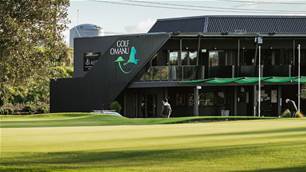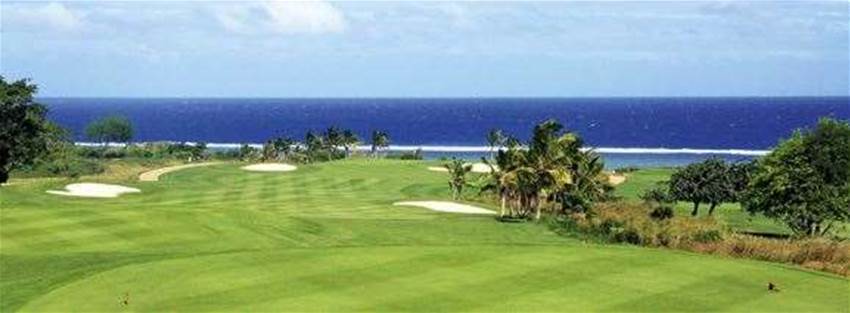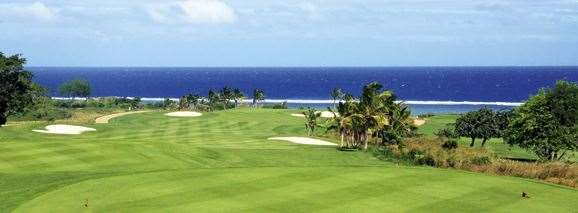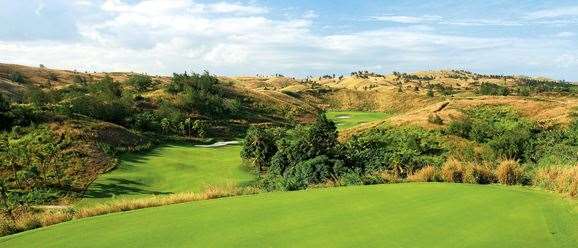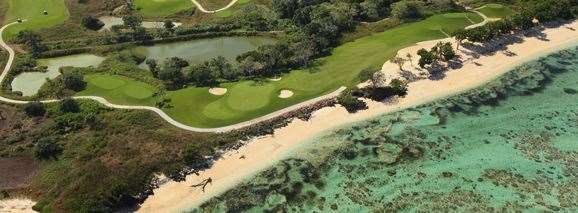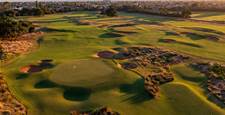Competitors in the inaugural Fiji International this August will encounter an excellent layout that combines the elements and scenery with ingenious design.
BY STEVE KEIPERT
It doesn’t take long to realise a round at Natadola Bay will linger in memory longer than most. The surrounding scenery and panoramic views across the Pacific Ocean are as striking standing on the 1st tee as the terrain tumbling before you down the opening par-4, where you watch your tee shot hang in the air against the all-blue backdrop before it falls to the steeply canted fairway below.
Yet mesmerising surroundings cannot mask the fact this is a serious course with serious penalties for wayward golf. Lining most holes is dense, tropical scrub and vegetation in which finding a ball is nigh impossible, let alone successfully extricating a sphere with a golf club. Such penal environs are not surprising, given the rugged, uncultivated nature of this piece of the Coral Coast along the south-western edge of Fiji’s main island, Viti Levu.
Attributing the design of Natadola (pronounced Nat-an-dola) is no easy task. Fijian golf icon Vijay Singh was the original designer, however a dispute involving Singh’s management at IMG in the years prior to the course’s opening in 2009 led to a withdrawal from the contract Singh and IMG had with the project. Singh’s design plans were ultimately tweaked by course-construction company Heritage Golf rather than overhauled, so plenty of design credit can rest with the towering Fijian.
Singh has agreed to return to Natadola Bay in a huge boost for the organisers of the inaugural US$1 million Fiji International this August 14 to 17. Yet his fellow competitors and tourists who take on the course before and after the event won’t care who is responsible for the layout so much as they’ll be concerned about their ammunition stocks. The layout is exposed to the strong coastal winds whipping off the Pacific Ocean and most holes are bordered by thick and mostly impenetrable tropical vegetation. Losing a dozen balls in one round is not difficult to do when the breeze is at full strength. The pros at the newest stop on the PGA Tour of Australasia won’t have the same luxury as everyday players do just after hitting their tee shots on the par-5 5th hole, where locals regularly wait with supplies of pre-loved balls, salvaged, cleaned and grouped by brand for convenient re-sale. Adding to your reserves here is never a bad idea, regardless of how successful your first few holes have been.
Natadola Bay offers an enchanting and at times mysterious combination of coastal water holes, cascading valley holes played from towering hilltop tees and moderate open holes nearer the clubhouse. Fijian touches are everywhere. Bala bala figureheads mark 150 metres to the centre of the greens and the tee markers are shaped like ‘neck-breakers’, tools to crack open coconuts. The course is split by a road that separates the 14 holes on the clubhouse and ocean side from four holes across the road that feature elevated tees, wild descents and sharp undulations. It’s a riveting excursion – as close to a roller-coaster ride as golf gets – as you scale a steep hill, alight the cart to bust a drive into the blue yonder then zoom downhill to retrieve it and navigate a path to the green.
Competitors in the 2009 and 2010 Fiji Opens already know this, and will be at a distinct advantage during the Fiji International. Victorian Open champion Matthew Griffin won that first Fiji Open at Natadola with a four-round total of one-over-par and triumphed by 11 strokes after being the only player to complete 72 holes without a double-bogey. A year later, Kiwi Michael Hendry finished five-over when he took the title in a play-off.
The opening holes are tough but playable. Rolling down, up and back down the natural undulations, the opening trio of par-4s leads play to the signature 4th hole, a 197-metre par-3 where shots drifting left can bounce into the world’s largest water hazard, such is the green’s proximity to the azure and inviting waters of the Pacific.
The test amps up from the 495-metre 6th, which kicks off a quartet of holes that can leave heads spinning. The descent from the 6th tee to the fairway might be 80 metres or more, your ball hanging against the sky for what seems an eternity before plummeting to the fairway below. Or so you hope … Miss this fairway on either side and parring this par-5 will be almost impossible thanks to the jungle-like foliage along both sides. The 7th is a downhill one-shotter to a green ringed by seven bunkers, some of which are not visible over the back edge. Try to emulate the feat of Krishna Singh, Vijay’s elder brother, who once aced this seductive little par-3. The 8th tee appears so high that altitude sickness can set in, until you reach the green of this down-and-up par-4 and realise the descent from the tee is almost matched by the rise to the elevated putting surface. The 387-metre 9th is another spectacular par-4 that bounds, trickles and rolls down a steep hill to a rippled green fronted by a yawning creek ready to swallow any approach that’s weak or right of the target.
Natadola Bay’s second nine is less wild but uses an open area to fine effect, while once again bringing play to the coast’s edge for two fine par-3s at the 13th and 15th. Tackling the water-laden 12th hole is not simple thanks to a rocky creek hugging the right side of the fairway that feeds a pond guarding the front of the green at the 300-metre par-4. The temptation is to eliminate all the trouble with a big drive but only the longest, straightest drivers will attempt such a bold play as a mid-iron from the tee then a short-iron second is more prudent.
First-timers need to be wary of the tee shot at the 363-metre 14th. The club has plans to build a new elevated tee to afford a better view of the fairway below but for now golfers need to be mindful of the water hazard lurking left of the cut grass that’s not visible from the current rear tee. Two bunkers along the right edge of the fairway offer a guide but the pond is blind and can catch tee shots straying left. The second shot plays sharply uphill to a hilltop green with a bunker short and right and all manner of native junk long and left. The 16th is a standout par-4 when played from the rear tee (344 metres) that requires a hefty carry to find dry land, while a rocky outcrop just off the cut grass can lead to helpful or unhelpful ricochets for drives that leak slightly left.
The pros’ best birdie chances – and yours – fall late in the round. The tiny par-3 15th puts a wedge in your hand (although a new back tee is planned for construction prior to the Fiji International) and a birdie in your mind, while two holes later the 502-metre 17th often plays downwind and is not only reachable in two shots, the green is open in front and receptive to running approaches, providing they are accurate.
If there is a criticism to be levelled at the layout it’s that all four par-3s run in the same direction – with the prevailing wind. The breeze might make life a little easier on the short holes, however they lose some variety as a result. Elements aside, the design of the quartet of one-shotters is sublime. The 4th attracts the photographers’ lenses for its proximity to the beach and features a green with a raised front-right portion and lower back-left section behind a bunker. The aforementioned 7th is short yet demands supreme judgment when it comes to club selection. The 201-metre 13th appears to mirror the 4th as the routing returns for a second close-up look at the coast but offers more latitude in each direction around the green. The 132-metre 15th is another peach where approaches need to be pinpoint as there is no option to chase the ball on.
An Australian, Steve Lalor, is the course superintendent at Natadola Bay. Lalor and his team routinely have the seashore paspalum surfaces in a condition befitting a course of this calibre. The greens in particular are exceptional. They are of a fair firmness, roll in truer fashion than the coarse-grain strains of Bermuda we’re accustomed to on golf courses in the tropics, plus they better resist the salty coastal Fijian air. More tropical seaside courses should investigate adopting this hardy yet highly presentable grass type.
Of course, the pros will discover this fact in August, but you can find it out for yourself anytime you like. Natadola Bay is fully accessible for public play and is considerably cheaper for guests staying at the adjoining InterContinental Fiji Golf Resort & Spa.
THE COURSE
LOCATION: Maro Rd, Natadola, Viti Levu, Fiji Islands. The course is a comfortable 45 to 50-minute drive south of Nadi and Nadi Airport via Queens Rd.
CONTACT: (0011) 679 673 3500; info@natadolabay.com
WEBSITE: www.natadolabay.com
DESIGNERS: Heritage Golf (2009).
PLAYING SURFACES: Seashore paspalum (fairways, greens and tees).
COURSE SUPERINTENDENT: Steve Lalor.
PGA PROFESSIONALS: Amitesh Chandra and Apenisa Koroicure.
GREEN FEES: FJ$230 (about A$135). Guests at the InterContinental pay FJ$165 (about A$100). Green fees include range balls and cart use.
THE CLUB
MEMBERSHIPS: Depending on how much golf you plan to play or how frequently you expect to return, joining the club can make smarter financial sense. Available from FJ$1,850 (and couples for FJ$2,775), annual membership fees cost the same as eight 18-hole rounds. There is no joining fee. Membership includes unlimited golf with cart.
FACILITIES: The full-length driving range is a perfect spot to warm up or hone your game with range balls included in the green fee. After your round, the clubhouse includes 95-seat Vatu Lo bar and restaurant with spectacular views across the course, coral reef and ocean beyond. Top-quality hire clubs are also available at FJ$60 per round.
ACCOMMODATION: The stunning five-star InterContinental Fiji Golf Resort & Spa is next door to the golf course. The 271-room resort adjoins Natadola Beach and features five restaurants and bars, a luxury spa, three swimming pools, a dive pool, kids club, plus wedding and conference facilities. The spacious, air-conditioned rooms are fitted with flatscreen TVs, DVD player and wireless internet.
PACKAGES: InterContinental and Natadola Bay offer a Memorable Escapes package that includes unlimited golf for two, accommodation, daily buffet breakfasts, return airport shuttle transfers, FJ$300 resort credit and a late check-out of 2pm. Rates vary according to timing.
Related Articles

Review: Omaha Beach Golf Club

Drinks With... Ricky Ponting
